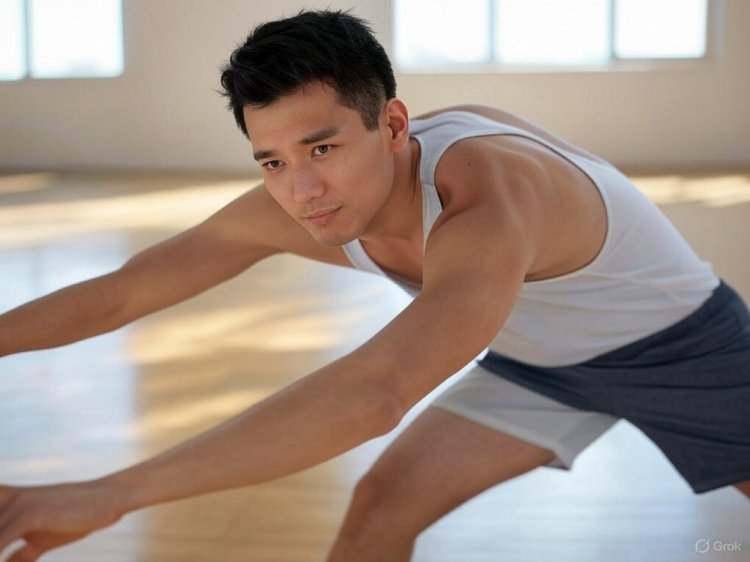A Simple Guide to Increasing Hip Flexor Flexibility

Tight hip flexors are a common issue for many people, whether due to prolonged sitting, intense workouts, or simply a lack of regular stretching. These muscles, located at the front of your hips, play a key role in movement, posture, and overall mobility. When they’re tight, you might experience discomfort in your hips, lower back, or even knees. Fortunately, improving hip flexor flexibility doesn’t require advanced skills or equipment—just consistency and a few targeted steps. Below is a simple guide to help you loosen up your hip flexors and move more freely.
Step 1: Understand Your Hip Flexors
Before diving into stretches, it’s helpful to know what you’re working with. The hip flexors are a group of muscles, including the iliopsoas, rectus femoris, and sartorius, that connect your pelvis to your thighs. They’re responsible for lifting your knees and bending at the hips. When they’re tight, your range of motion can shrink, and compensations elsewhere in your body might lead to pain or injury. Recognizing their role sets the stage for effective stretching.
Step 2: Warm Up Properly
Stretching cold muscles can do more harm than good, so start with a light warm-up. Five to ten minutes of dynamic movement—like walking, leg swings, or gentle lunges—gets blood flowing to your hips and prepares the muscles for deeper work. A warm-up increases elasticity, making your hip flexors more receptive to stretching without strain.
Step 3: Perform the Kneeling Hip Flexor Stretch
One of the most effective stretches for hip flexors is the kneeling stretch. Here’s how to do it:
-
Kneel on one knee with the other foot planted flat in front, forming a 90-degree angle at both knees.
-
Keep your torso upright and gently push your hips forward until you feel a stretch in the front of the kneeling hip.
-
Hold for 20-30 seconds, breathing deeply, then switch sides. Aim for 2-3 rounds per side. This stretch targets the iliopsoas directly and opens up the hip joint.
Step 4: Add a Quad Stretch Variation
Since the rectus femoris (part of your quadriceps) doubles as a hip flexor, stretching your quads can enhance flexibility. Stand tall, grab one ankle behind you with the same-side hand, and pull your heel toward your glutes. Keep your knees close together and push your hips slightly forward to feel the stretch in both your quad and hip flexor. Hold for 20-30 seconds per leg, repeating twice. If balance is an issue, hold onto a wall or chair.
Step 5: Incorporate the Butterfly Stretch
This seated stretch broadens the focus to your inner thighs and hips, complementing hip flexor work. Sit on the floor, bring the soles of your feet together, and let your knees fall outward. Hold your feet with both hands and gently press your knees toward the ground using your elbows. Keep your back straight and hold for 30 seconds. Repeat 2-3 times. This stretch improves overall hip mobility, indirectly easing tension in the flexors.
Step 6: Practice Consistency and Patience
Flexibility doesn’t improve overnight. Aim to stretch your hip flexors 4-5 times a week, holding each stretch for at least 20-30 seconds and repeating as needed. Over time—typically a few weeks—you’ll notice greater ease in movements like squatting, lunging, or even sitting comfortably. Pair stretching with mindful posture during the day (avoid slumping!) to reinforce your progress.
Step 7: Listen to Your Body
While stretching should feel challenging, it shouldn’t be painful. If you experience sharp discomfort or pinching, ease off and adjust your position. Overstretching can strain the muscles or joints, so progress gradually. If tightness persists despite regular stretching, consider consulting a physical therapist for personalized advice.
Keys to Boost Hip Flexor Flexibility
-
Know the Muscles: Understand the hip flexors’ role in movement to target them effectively.
-
Warm Up: Start with 5-10 minutes of light activity to prep your muscles.
-
Stretch Regularly: Use the kneeling stretch, quad stretch, and butterfly stretch 4-5 times weekly.
-
Stay Consistent: Hold stretches for 20-30 seconds and repeat for gradual improvement.
-
Avoid Pain: Stretch to a comfortable limit, not beyond, to prevent injury.
By following these steps, you’ll unlock tighter hips, enhance mobility, and feel better in your daily activities. Stick with it, and your body will thank you!